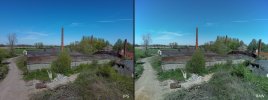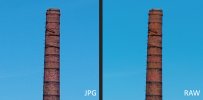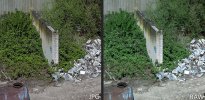You read it countless times: "RAW/DNG is SO much better!" Blahblahblah ...
Maybe you tried for yourself - and found the RAW/DNG photos looking just horrible!
So you came to the conclusion: "Just steaming bullsh... all those RAW/DNG disciples claim!!!"
Now have a look at the pictures and the two cutouts taken from that pictures - and make up your mind.
This demonstrates just the quality improvements; there's even more benefits RAW/DNG files provide you, like being able to "rescue" underexposed and overexposed picture parts.


In the RAW, you can still see that smokestack is made of bricks; just a blurred mess in the JPG. Plus, there's noise in the sky in the JPG.

Just look at the foliage, big fat "lineart" in the JPG, far more details in the RAW.
Maybe you tried for yourself - and found the RAW/DNG photos looking just horrible!
So you came to the conclusion: "Just steaming bullsh... all those RAW/DNG disciples claim!!!"
Now have a look at the pictures and the two cutouts taken from that pictures - and make up your mind.
This demonstrates just the quality improvements; there's even more benefits RAW/DNG files provide you, like being able to "rescue" underexposed and overexposed picture parts.


In the RAW, you can still see that smokestack is made of bricks; just a blurred mess in the JPG. Plus, there's noise in the sky in the JPG.

Just look at the foliage, big fat "lineart" in the JPG, far more details in the RAW.
Last edited:




